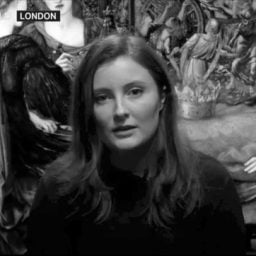Art & Exhibitions
Monet’s Obsessive Paintings of the Thames Reunited in London for the First Time in 120 Years
A once-in-a-lifetime exhibition is on view now at the Courtauld in London.

When most think of Monet, their mind brings forth sunsets on the Seine or water lilies from his beloved flower garden in Giverny in northern France. Sooty scenes of industrial London may be a less obvious reference, but the Impressionist painter became enchanted by the Big Smoke on his first visit in 1870. Decades later, between 1899-1901, Monet returned three times to obsessively repaint the river Thames.
These works are the subject of a landmark exhibition “Monet in London: Views of the Thames,” opening at the Courtauld in London on September 27. It reunites 21 paintings that debuted as part of a larger group of 37 works in Paris in 1904. The artist’s intention to show the “Thames” series in London never came to be until now, some 120 years later. The exhibition has attracted the biggest advance ticket sales in the Courtauld Gallery’s history.
Among the exhibition’s highlights is a historically significant view of Charing Cross Bridge once owned by Winston Churchill, which has recently been restored to its former glory after decades of the former prime minister’s cigar smoke was cleaned from it.
Of course, the Courtauld couldn’t be a more ideal location, being mere stone’s throw from the artist’s main subjects of Waterloo Bridge, Charing Cross Bridge, and the Houses of Parliament, and just a few doors down from his regular haunt: the Savoy Hotel. Contemporary viewers will see first-hand how the other-worldly smog that draped the city of Monet’s day has evolved into a lively cacophony of flashing lights and skyscrapers.
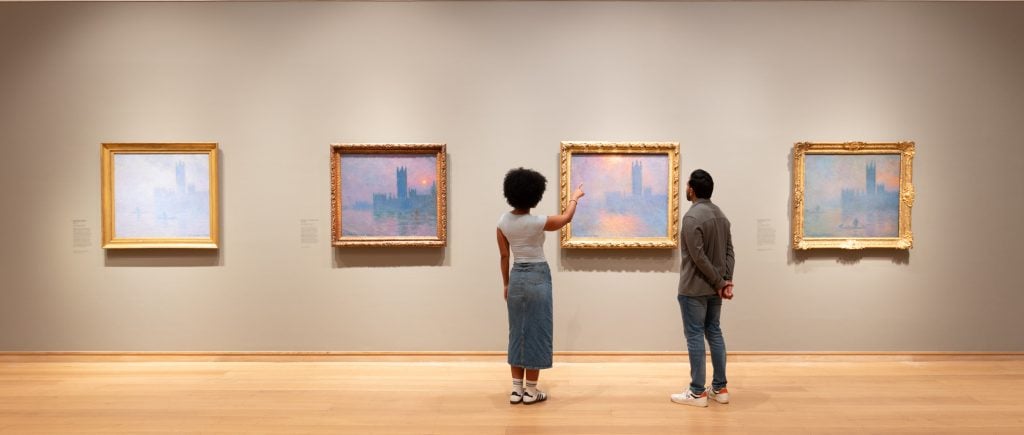
Installation view of “Monet and London: Views of the Thames,” at The Courtauld Gallery in London. Photo: © Fergus Carmichael.
What was it that kept Monet coming back to set up his easel along the same London riverbanks? It wasn’t the city’s stately monuments, which he makes hardly discernible beyond a hazy silhouette. Rather, the artist marveled at the city’s ever-changing atmospheric conditions.
“It has to be said that the climate is so idiosyncratic;” Monet wrote to his wife in 1900. “You wouldn’t believe the amazing effects I have seen in the nearly two months that I have been constantly looking at this river Thames.”
Years later, in 1920, he recalled how London’s “fog gives it its magnificent breadth. Its regular and massive blocks become grandiose within that mysterious cloak.”
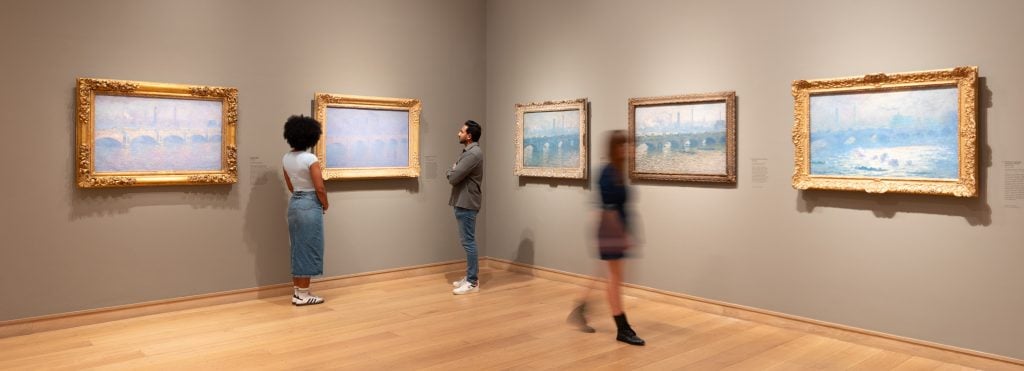
Installation view of “Monet and London: Views of the Thames,” at The Courtauld Gallery in London. Photo: © Fergus Carmichael.
Though Monet returned relentlessly to the same locations, the weather and the time of day made each painting wholly individual. Responding to an unpredictable climate, Monet usually stopped and started sketching on several different canvases each day, eventually completing the unfinished works from his studio in Giverny.
“It may feel repetitive to represent the same thing over and over, but for him it wasn’t at all,” explained the Courtauld’s senior curator Karen Serres. “Every time he was seeing something completely different. He realized that to represent a specific site only once was not to do it justice.”
This effect is greatly emphasized when the works are viewed as a group. Even as Monet was working on the “Thames” series, he refused to send a single canvas to his dealer. “Seeing the complete series will be of far greater importance,” he insisted. As such, the Courtauld show presents a once-in-a-lifetime opportunity to see together loans from as far afield as Ottawa, Atlanta, Zurich, and Dublin.
Here, Serres offers unique insights into exemplary works from each of Monet’s three preferred locations.
Waterloo Bridge
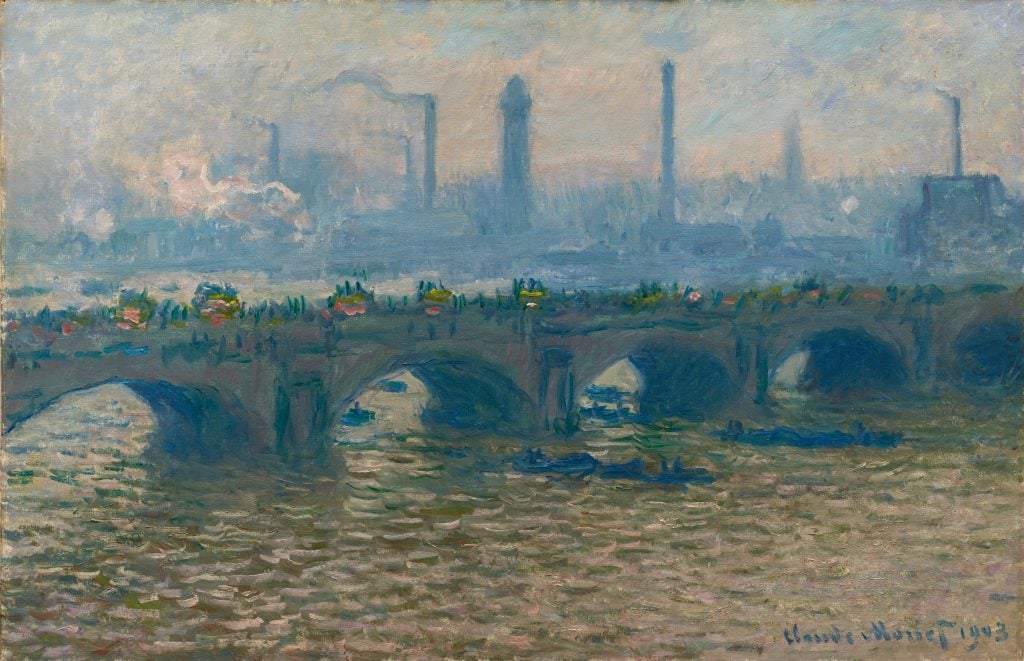
Claude Monet, Waterloo Bridge, Overcast (1903). Photo: Anders Sune Berg, courtesy of Ordrupgaard, Denmark.
From his suite on the top floor of Savoy, Monet could see a skyline of chimneys emanating steady plumes of smoke. As this pollution came into contact with vapor rising from the river, it enveloped the city in a delicate shroud of fleeting visual effects. For Monet, this presented an exciting challenge. “My practiced eye has found that objects change in appearance in a London fog more and quicker than in any other atmosphere, and the difficulty is to get every change down on canvas,” he told a journalist in 1901.
“This painting shows you all the activity on the river,” said Serres, noting how blobs of color represent horse-drawn double-decker buses making their way across the bridge as barges pass beneath. “Really, this is a reminder that the Thames is a working river and a thoroughfare.”
“Monet has rendered the semi-agitated river with just these very quick brushstrokes that are slightly pinkish ochre,” she added. “That really animates the river.”
Houses of Parliament
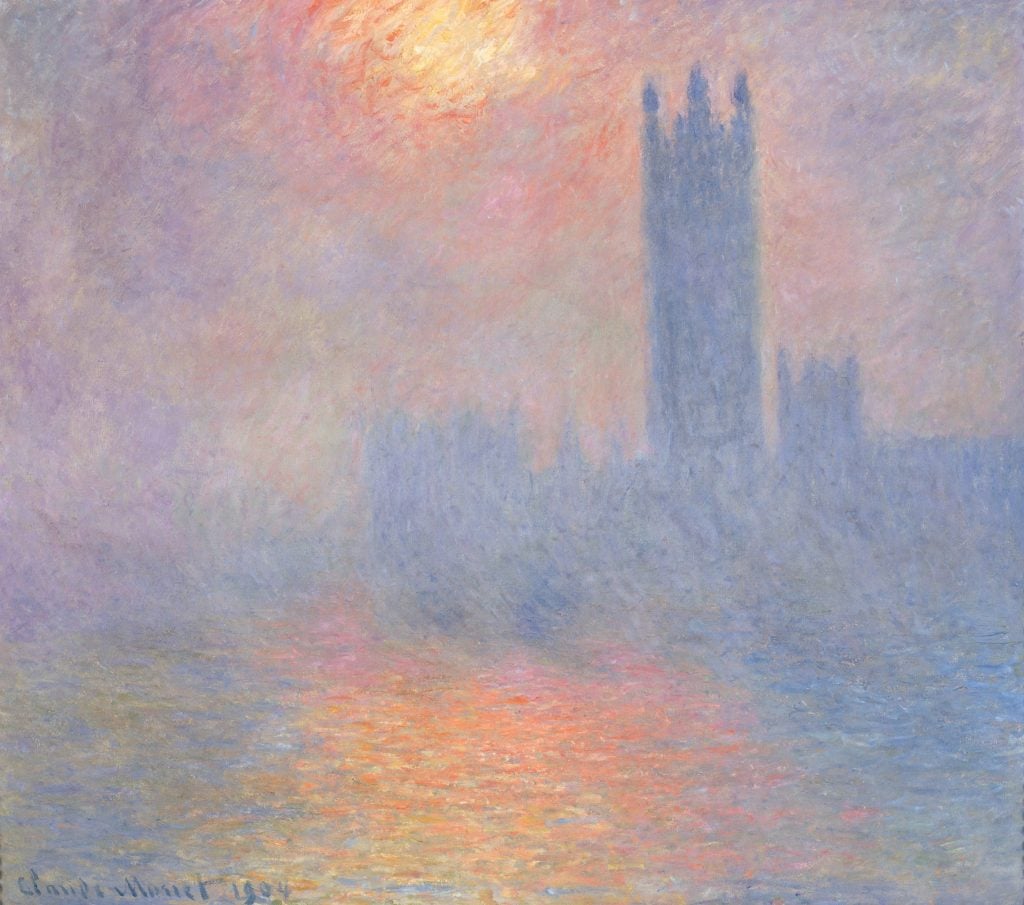
Claude Monet, London, Parliament. Sunlight in the fog (1904). Photo: Hervé Lewandowski, © Grand Palais RMN (Musée d’Orsay).
In February 2020, Monet began crossing over to the south bank and painting the Houses of Parliament from a private terrace in St Thomas’s Hospital. The dramatic neo-Gothic architecture cut a striking figure, looming out from the mist. Monet particularly loved when the sun, which he described as “a huge ball of fire,” began to sink behind the rooftops.
Of this painting, Serres notes how “the sun is just piercing through the clouds, illuminating the Thames in the foreground. Of course, Monet as a colorist uses complementary colors very well. The sunlight at dusk is very orange in contrast to the building, which is this purple-y blue.”
Charing Cross Bridge
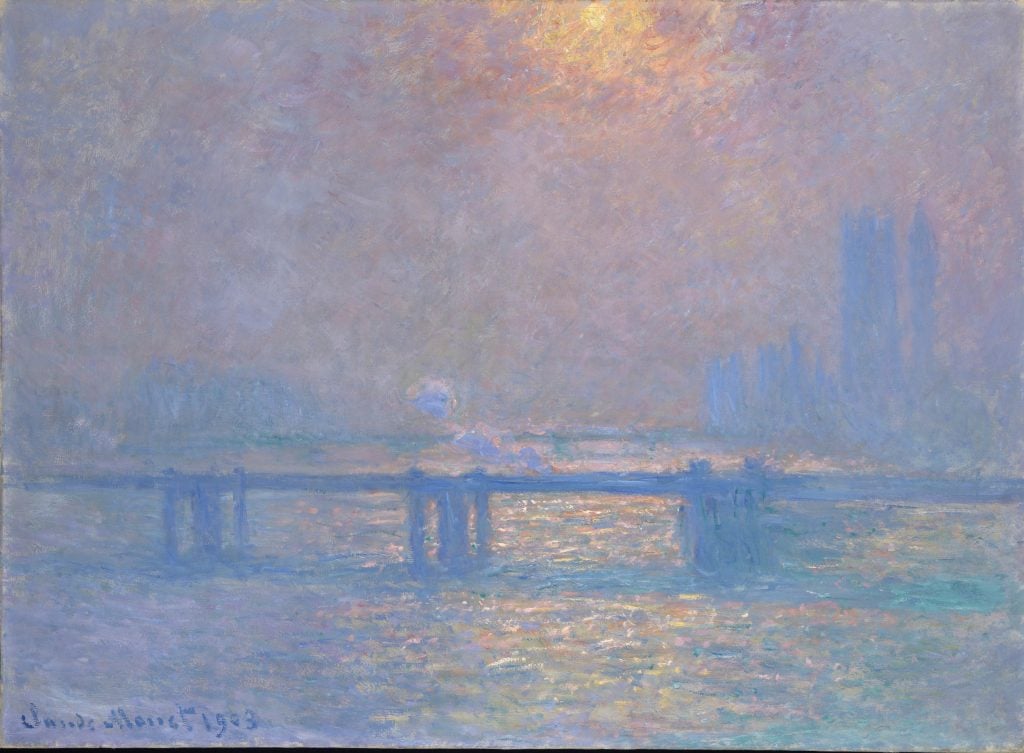
Claude Monet, Charing Cross Bridge, the Thames (1903). Photo: Alain Basset, © Lyon MBA.
Everyday modern life is depicted in Monet’s studies of Charing Cross Bridge, a railway often populated by a passing train billowing clouds of steam. Serres praised how in these paintings Monet produced a “much more subdued sun that on the river sheds an orange light.” In some of these examples, “the fog has dissolved all the forms,” so that the composition “almost goes towards abstraction. But the more you look, the more you realize the subtlety in the sky and then you see these forms emerging from the fog.”
Another view of Charing Cross Bridge, dated 1902 but actually completed in 1923, was given to Winston Churchill in 1949 by his literary agent. It was accompanied by a note urging the ex-prime minister, at that time leader of the opposition party, to “dissipate the fog that shrouds Westminster,” a reference to the U.K.’s seat of power. It still belongs to Churchill’s country house Chartwell, now a National Trust property.
We can only guess at what Monet might have made of the changing atmospheric conditions to which this particular “Thames” study would continue to be subjected to, and eventually bear the traces of. The composition is primarily yellow, a reflection of Victorian London’s highly sulfurous air, but it has only recently regained the full effects of this sickly pale glow thanks to a recent restoration effort.
Among the sources of airborne grime to have accumulated on the painting’s surface? As well as soot from the fireplace, potentially smoke from Churchill’s ten Cuban cigars a day, National Trust conservator Rebecca Hellen told The Art Newspaper.
“Monet and London: Views of the Thames” is on view at the Courtauld in London until January 19.

